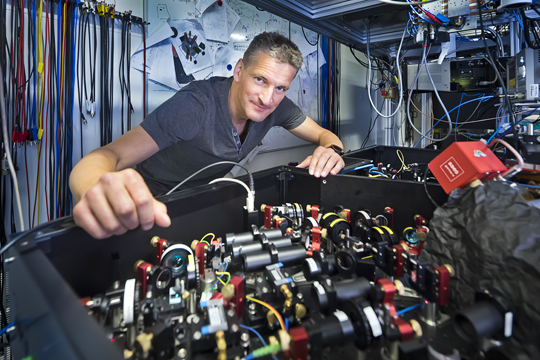Absurd Laws
Freiburg, Aug 01, 2019
The first musings on quantum mechanics are about a century old. "Nevertheless, the findings are still often perplexing today, or even unsettling," says Tobias Schätz, a Professor of Experimental Physics at the University of Freiburg. They sound like so much science fiction and contradict conventional knowledge and the laws of classical physics radically. Much remains unknown. At the same time, great hopes are being placed in possible technological applications, such as the often invoked quantum computer.

EUCOR – The European Campus has made quantum physics a research focus. Photo: Ezume Images/stock.adobe.com
EUCOR – The European Campus, the confederation of universities on the Upper Rhine, has made quantum physics a research focus. Two major projects are currently underway in Freiburg that serve to promote young academics and basic research. Schätz says, however, that he favors the term "curiosity-driven research." The priority, according to Schätz, isn't to develop actual patents. "My idea of this quantum focus is that we educate a next generation of physicists who are able to ask the correct questions and develop concepts on their own," Schätz adds.
The fathers of quantum mechanics
Physicists such as Albert Einstein, Erwin Schrödinger, and Werner Heisenberg are among the originators of the theories of quantum mechanics. "At the start of the 20th Century they were involved, above all, in thought experiments," says Schätz. Actual experimental research would have been unimaginable back then, he explains. Their basic assumption was that other laws applied to the quantum world – the "little world" within the size range of atoms and smaller – than did to the "big" world of classical physics. As a result, in the quantum world, for example, an object can take on wavelike properties and be in different places at the same time.
Today, quite a few decades and Nobel prizes later, many of the assumptions of quantum theory can be tested in the laboratory. In what can be described at least as small, clean, controlled, and stable systems, says Schätz, it is possible to observe that the absurd assumptions formulated by the fathers of quantum mechanics are actually right on target. He continues: "And research has in the meantime gone a step further and is trying to implement them in applications."
Simultaneously on and off
A famous example of this is the quantum computer, which is being researched world-wide. Schätz emphasizes that it will only be usable in twenty or thirty years at the earliest. Nevertheless, the idea fascinates researchers and companies alike. A conventional computer's smallest unit of information is a bit (from "binary digit"). It has only two values: 0 and 1 - off and on. A quantum computer, by contrast, is said to work with what are known as qubits or quantum bits. Thanks to quantum mechanical processes, these can simultaneously be in two states – simultaneously 0 and 1. Scientists call this superposition. "It's a nightmare for engineers building conventional computers," says Schätz. "Yet when you exploit these processes, a quantum computer can perform phenomenally," he adds.

"We quantum physicists are more likely to be disappointed when our experiments come up with results that we've already imagined," says Tobias Schätz. Photo: Jürgen Gocke
Schätz says however, that he doesn't view it as the university's task to take part in a race with technology companies to build the first quantum computer. He explains that at the University of Freiburg, there is a great deal of exchange between researchers such as Prof. Dr. Andreas Buchleitner, who are involved with the theories of complex quantum systems as well as colleagues who are dedicated to experimental implementations. Based on its research focus, says Schätz, it is precisely the University of Freiburg that is in a position to continue dedicating itself to basic research and training while asking questions of research policy and ethics with regard to the future use of quantum technologies. "I think the EU is a good location for this," he notes.
"QUSTEC" launched
In the spring of 2019, the European Commission approved an application to support an international doctoral program in quantum science. It's known as "QUSTEC." The abbreviation stands for "Quantum Science and Technologies at the European Campus." In addition to the University of Freiburg, the Universities of Basel and Strasbourg, as well as the Karlsruhe Institute of Technology (KIT), and the research department of the IT company IBM in Zürich are taking part. The program aims to finance the doctorates of forty quantum researchers. The higher educational institutions taking part in the program are offering forty further positions for doctoral candidates. The program is set to run for five years and has 9.1 million euros of funding. The EU is supplying 4.2 million euros of that total, with the remainder coming from the partners and additional donors.
The Universities of Freiburg and Basel have already been home to the cooperative center of excellence called "Quantum Science and Quantum Computing" for two years. It offers ten postdoctoral research positions that are financed by the Georg H. Endress Foundation ("Georg-H.-Endress-Stiftung") of Switzerland. "That totals to one hundred post-doc years," says Schätz, "and they're not tied to developing patents. It's would be rare to find something like that in the business world."
Atom-by-atom
Schätz says the research projects being done in Freiburg aim, among other things, to investigate what happens when very small, controlled, quantum mechanical systems are expanded in the lab. "We introduce one atom at a time and observe what changes," he adds. As an illustration, Schätz describes an ultra-cold chemistry project. According to the classical laws of natural science, atoms move more slowly the colder it gets, so the number of chemical reactions is correspondingly reduced. Yet when quantum mechanical wave-particle duality becomes dominant, the atoms are everywhere, says Schätz. He adds, "They overlap each other without moving – and let chemistry unfold."
Schätz continues that Einstein was already describing such effects as "spooky." "Of course it's confusing when atoms don't behave according to the classical nuclear model – so they don't appear as balls, but waves," says Schätz. And that's exactly what it's all about, he goes on, investigating what has yet to be known and understood and developing models that have been unimaginable up to now. "It's about a paradigm shift," he says, "We quantum physicists are more likely to be disappointed when our experiments come up with results that we've already imagined."
Thomas Goebel

